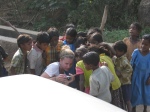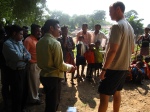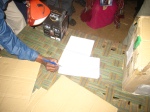Villages of Koraput, Revisited
January 5, 2010
Returning to the villages in the Koraput District in southern Orissa after a year was quite an experience. We distributed 260 lights to the villagers, which was 10 more than our goal of 250 and almost a 100 more than last year’s 162. To say the trip was a success would be an understatement. In addition to getting the lights to the villagers, we were able to revisit the beneficiaries of last year’s project and collect data about our first deployment. We were also able to lay the groundwork for future deployments which won’t require one of us to be present. This means an even higher percentage of donated funds will be put directly towards the purchase of solar lights.
That we were able to distribute 260 lights in eight days, compared to the two months needed last year for almost 100 less lights speaks to the steep learning curve we’ve experienced. I may have previously mentioned (and if I haven’t, I’ll do so now) that one of the biggest obstacles we had last year was not convincing the villagers of the value of the lights, but convincing an NGO to work with us on our distribution model. They all said it wouldn’t work and that the villagers wouldn’t pay for the lights. Well this year we had none of that. Our NGO partner, SOVA, had seen firsthand how successful our initial project had been and was eager to support us on our second one. The very thin grapevine between the neighboring villages meant a lot of households, learning of the lights’ benefits, were eager to get a light of their own. So we had the customers and we had the support of respected local NGO; once the logistics of shipping were finalized, the distribution went rather smoothly.
One of the reasons we were able to get so many lights into the hands of so many villagers in such a short time was the access to SOVA’s volunteer network. Most of the villagers worked in the fields during the day and the distance between villages was too great to visit more than one per night. To get around this issue, we left lights with multiple volunteers who were able to distribute the lights simultaneously. When we met with the volunteers on that last day, we were a bit anxious to hear how distribution went without direct Beyond Solar supervision. As we sat listening to them speak, we realized just how great the need is. Even after all of the lights were “sold” more villagers continued to show up. “The villagers are very happy,” one volunteer told us. “But they need more… 500 more lights.” Once again, the only issue was that we had more customers than we did lights!
The villagers requests for more lights means we have a lot more work to do but it was the villagers who had used the lights for a year who really encouraged us that donors money was well spent. All of the benefits previously mentioned were verified: longer working hours during the day and little to no money spent on kerosene meant more disposable income for food or medical emergencies. Children are studying now at night and village leaders are routinely meeting at night to discuss issues facing their community. The villagers are protecting their crops during the evening and protecting their families by providing them with cleaner air and removing the threat of open fire. The payments made for the lights were deposited into the village development committee and later used to invest in mushroom cultivation projects and to keep money on hand for medical emergencies. I could go on and on, but one Puki villager summed it up by simply saying, “We are so grateful for you providing these lights. They’ve changed our lives.”
Hearing that one comment made the trip all worthwhile, and I hope it makes every donor feel the same way. Without your support, none of this would have been possible. Thank you so much.



















